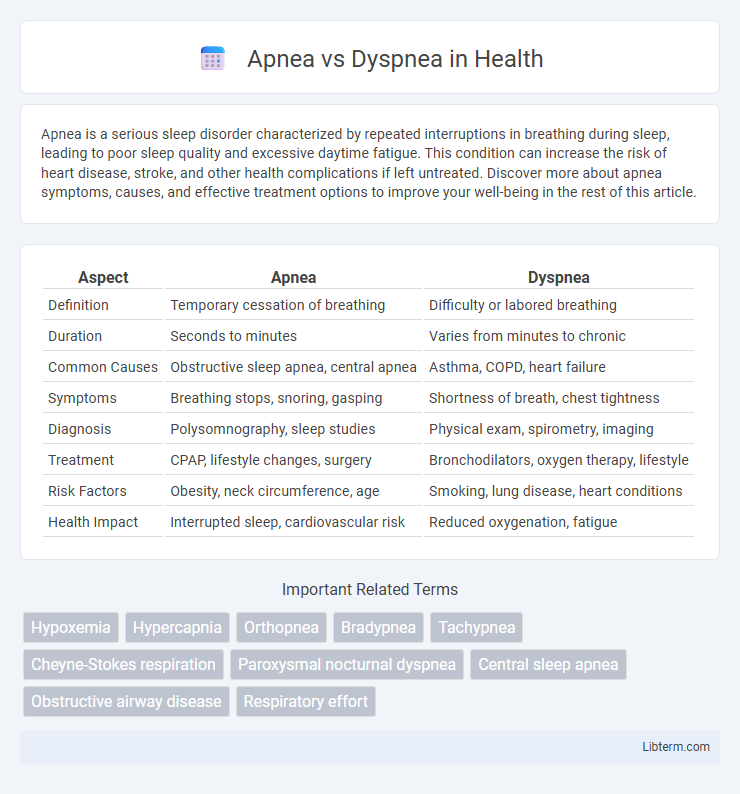Apnea is a serious sleep disorder characterized by repeated interruptions in breathing during sleep, leading to poor sleep quality and excessive daytime fatigue. This condition can increase the risk of heart disease, stroke, and other health complications if left untreated. Discover more about apnea symptoms, causes, and effective treatment options to improve your well-being in the rest of this article.
Table of Comparison
| Aspect | Apnea | Dyspnea |
|---|---|---|
| Definition | Temporary cessation of breathing | Difficulty or labored breathing |
| Duration | Seconds to minutes | Varies from minutes to chronic |
| Common Causes | Obstructive sleep apnea, central apnea | Asthma, COPD, heart failure |
| Symptoms | Breathing stops, snoring, gasping | Shortness of breath, chest tightness |
| Diagnosis | Polysomnography, sleep studies | Physical exam, spirometry, imaging |
| Treatment | CPAP, lifestyle changes, surgery | Bronchodilators, oxygen therapy, lifestyle |
| Risk Factors | Obesity, neck circumference, age | Smoking, lung disease, heart conditions |
| Health Impact | Interrupted sleep, cardiovascular risk | Reduced oxygenation, fatigue |
Understanding Apnea: Definition and Causes
Apnea is a temporary cessation of breathing lasting at least 10 seconds, commonly caused by obstructive factors, central nervous system dysfunction, or mixed origins. Obstructive sleep apnea results from airway blockage during sleep, while central apnea stems from impaired respiratory control in the brain. Understanding these causes is crucial for accurate diagnosis and tailored treatment strategies.
Dyspnea Explained: What Does It Mean?
Dyspnea refers to the subjective experience of breathing discomfort, characterized by sensations of shortness of breath, labored breathing, or chest tightness. It results from complex interactions among physiological, environmental, social, and psychological factors affecting respiratory function. Understanding dyspnea involves assessing underlying causes such as pulmonary diseases, cardiac conditions, or neuromuscular disorders to provide accurate diagnosis and effective management.
Key Differences Between Apnea and Dyspnea
Apnea refers to a temporary cessation of breathing, often lasting seconds to minutes, whereas dyspnea is the subjective sensation of difficult or labored breathing. Apnea is characterized by an absence of airflow despite respiratory effort, commonly observed in sleep apnea or central nervous system disorders. Dyspnea involves increased respiratory drive and discomfort, frequently associated with conditions like asthma, heart failure, or chronic obstructive pulmonary disease (COPD).
Common Symptoms of Apnea and Dyspnea
Apnea commonly presents with brief pauses in breathing, loud snoring, and excessive daytime sleepiness due to interrupted airflow during sleep. Dyspnea is characterized by shortness of breath, chest tightness, and an increased respiratory rate often linked to underlying cardiac or pulmonary conditions. Both symptoms require clinical evaluation to identify underlying causes and initiate appropriate treatment.
Risk Factors Associated with Apnea and Dyspnea
Apnea is primarily linked to risk factors such as obesity, smoking, alcohol use, and certain anatomical abnormalities like enlarged tonsils or a deviated septum, which contribute to airway obstruction during sleep. Dyspnea often results from cardiovascular and pulmonary conditions including chronic obstructive pulmonary disease (COPD), asthma, heart failure, and anemia, which impair oxygen delivery or lung function. Understanding these risk factors is critical for accurate diagnosis and effective treatment of respiratory disorders.
Diagnostic Approaches for Apnea vs Dyspnea
Diagnostic approaches for apnea primarily include polysomnography, which monitors respiratory effort, airflow, blood oxygen levels, and sleep stages to identify cessation of breathing during sleep. Dyspnea evaluation involves a combination of patient history, physical examination, arterial blood gas analysis, chest X-rays, pulmonary function tests, and echocardiography to determine underlying cardiac or pulmonary causes. Advanced imaging techniques such as CT scans or MRI may also be employed to differentiate structural abnormalities contributing to dyspnea.
Treatment Options for Apnea
Treatment options for apnea primarily involve continuous positive airway pressure (CPAP) therapy, which keeps airways open during sleep. Alternative interventions include oral appliances designed to reposition the jaw and tongue, improving airflow, and in severe cases, surgical procedures such as uvulopalatopharyngoplasty (UPPP) may be necessary. Lifestyle modifications like weight loss, avoiding alcohol, and sleeping on one's side also contribute significantly to reducing apnea symptoms.
Treatment Options for Dyspnea
Treatment options for dyspnea focus on addressing the underlying cause, such as bronchodilators for asthma or COPD, diuretics for heart failure, and supplemental oxygen for hypoxemia. Non-pharmacological interventions include pulmonary rehabilitation, breathing techniques like pursed-lip breathing, and lifestyle modifications such as smoking cessation. In severe cases, mechanical ventilation or opioid therapy may be used to relieve refractory breathlessness.
Prevention Strategies for Breathing Disorders
Effective prevention strategies for breathing disorders involve reducing exposure to pollutants, practicing regular respiratory exercises, and maintaining a healthy lifestyle to mitigate risks of apnea and dyspnea. Sleep apnea prevention includes managing weight, avoiding alcohol before bedtime, and using prescribed CPAP devices to ensure airway patency. For dyspnea, controlling underlying conditions such as asthma, COPD, or heart disease through medication adherence and routine medical check-ups is critical in minimizing symptom onset.
When to Seek Medical Help for Breathing Issues
Apnea is the complete cessation of breathing, often occurring during sleep and indicating possible sleep apnea requiring urgent medical evaluation. Dyspnea refers to the sensation of breathlessness or difficulty breathing and warrants immediate medical attention if accompanied by chest pain, bluish lips, or sudden onset. Seek emergency care if breathing difficulties are severe, persistent, or paired with other alarming symptoms like confusion or fainting.
Apnea Infographic

 libterm.com
libterm.com